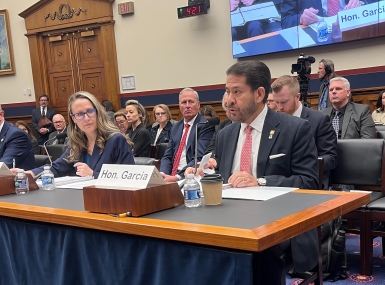Intergovernmental Disaster Reform Task Force
Strengthening Federal Disaster Assistance and Intergovernmental Collaboration

The NACo Intergovernmental Disaster Reform Task Force was launched in November 2024 to strengthen our nation's disaster mitigation, response and recovery capabilities. This will be achieved by modernizing federal disaster policies; strengthening intergovernmental partnerships; and enhancing local disaster mitigation, response and recovery capacities. As disasters intensify across the country, county governments play a crucial role on the frontlines of emergency management and recovery.
With a commitment to advancing federal policies that foster collaboration between counties, federal agencies and other intergovernmental partners, the Task Force builds on years of county-led efforts to enhance disaster policies and practices, driving improved outcomes nationwide.
Become a Friend of the Task Force | Download the Task Force Scoping Document | Download the One-Pager
In 2023:
Counties are not merely stakeholders in this conversation but a part of the federal-state-local-tribal partnership of governments that together share the responsibility of protecting our nation and our residents from all types of disasters.
849
counties experiences at least one federally declared disaster
720
counties had at least one disaster declaration
312
counties had at least one emergency declaration
2000-2023 Number of Major Disaster Declarations
Click here to view in a new window
About the Task Force
Through advancing county policy priorities, elevating local strategies, and amplifying county voices, the Task Force will:
- Ignite a national focus on disaster resilience by fostering strong intergovernmental partnerships and emphasizing the need for systemic reform to improve the nation’s preparedness, response and recovery capabilities.
- Highlight the critical roles, innovations and challenges faced by county governments in disaster management, ensuring that counties remain integral partners in federal and state disaster policies and practices.
- Achieve public policies that strengthen county capacity to mitigate, respond to and recover from disasters. Key policy goals include streamlining federal disaster funding, improving access to technical assistance and training and enhancing support for long-term recovery initiatives that address the growing frequency and severity of disasters.
- Align a cohesive national and intergovernmental strategy for disaster reform, focusing on building more resilient communities through collaboration among federal, state, tribal and local governments, with special attention to underserved and vulnerable populations.
Membership for this Task Force was appointed by NACo President James Gore in November 2024.
Co-ChairS
Hon. Adrian Garcia, Commissioner, Harris Co., Texas | Chair, NACo Justice & Public Safety Policy Steering Committee
Hon. Cynthia Lee Sheng, Parish President, Jefferson Parish, La.
ELECTED OFFICIALS
Hon. Paul Anderes, Commissioner, Union Co., Ore.
Hon. Barry Anderson, Supervisor, Clay Co., Iowa
Hon. Dakkia Bradshaw, Commissioner, Telfair Co., Ga.
Hon. Ken Burke, Comptroller, Pinellas Co., Fla.
Hon. Ron Burrows, Commissioner, Rogers Co., Okla.
Hon. Paula Dance, Sheriff, Pitt Co., N.C.
Hon. Allen Dodson, Judge, Faulkner Co., Ark.
Hon. Lena Fowler, Supervisor, Coconino Co., Ariz. | Chair, NACo Rural Action Caucus
Hon. Heidi Hall, Supervisor, Nevada Co., Cali.
Hon. Dwayne McFall, Commissioner, Fremont Co., Colo. | Second Vice President, NACo Western Interstate Region
Hon. Sharon Green Middleton, Councilmember, Baltimore City, Md. | Vice Chair, NACo Large Urban County Caucus
Hon. Tamara Paltin, Councilmember, Maui Co., Hawaii
Hon. Jessica Pyska, Supervisor, Lake Co., Calif.
Hon. Dave Somers, County Executive, Snohomish Co., Wash.
Hon. Bill Truex, Commissioner, Charlotte Co., Fla.
Hon. Mark Poloncarz, County Executive, Erie Co., N.Y.
Hon. Larry Waters, Mayor, Sevier Co., Tenn.
Hon. Frank Williams, Commissioner, Brunswick Co., N.C. | Chair, NACo Resilient Counties Advisory Board
COUNTY EXPERTS & STATE ASSOCIATION OFFICIALS
Pat Alesandrini, Assessor, Hillsborough Co., Fla.
Nick Crossley, Director, Emergency Management and Homeland Security Agency, Hamilton Co., Ohio
Jeff DuVall, Director, Dept. of Emergency Management, Sonoma Co., Calif.
Judd Freed, Director of Emergency Management, Ramsey Co., Minn.
Jim Henderson, Executive Director, Kentucky Association of Counties
Matt Machado, County Engineer, Santa Cruz Co., Calif.
Monica Nino, County Administrator, Contra Costa Co., Calif.
Eric Poole, Executive Director, Institute for County Govt., Florida Association of Counties
Cody Powell, Emergency Management Coordinator, Wise Co., Texas
Task Force Federal Policy Priorities
Provide recommendations for reforms and best practices for essential federal programs that improve disaster mitigation at the county level, including direct technical support, reduced administrative burdens and public accountability.
- Assess how federal assistance can better support pre-disaster mitigation projects at the county level, including multi-benefit projects.
- Explore lessons learned with mitigation programs like FEMA’s Hazard Mitigation Grant Program (HMGP), Building Resilient Infrastructure and Communities (BRIC) and Public Assistance – Mitigation, HUD’s CDBG-Mitigation Program, and USDA Watershed Protection.
Enhance the existing framework for federal, state, tribal and local partners to collaborate in a transparency and trusted manner in disaster response efforts.
- Improve the coordination of federal and state disaster response resources with county-level emergency management efforts, including combatting mis-and-dis information.
- Address barriers counties face in accessing federal resources in the immediate aftermath of a disaster and identify solutions to expedite funds, particularly for rural and under resourced communities.
Expand access to the FEMA Public Assistance Dashboard, allowing county officials to track and address quality control and accountability issues with reimbursement claims.
- Streamline recovery programs and increase transparency on reimbursements to reduce administrative burdens and speed up assistance to affected counties.
- Enhance training and capacity building of county officials of FEMA rules and procedures.
- Analyze the impact of delays in federal disaster recovery funding on local communities.
Strengthen the capacity and skills of county officials to plan for and respond to disasters.
- Identify training and technical assistance opportunities for county officials.
- Secure national-level partnerships to offer and sustain capacity building programs and resources for county officials, including covering the fundamentals of federal resources.
Thanks to our Sponsors
Thank you to Hagerty Consulting, the Institute for Building Technology and Safety (IBTS) and Pew Charitable Trust for partnering with NACo and sponsoring the Intergovernmental Disaster Reform Task Force.
Hagerty Consulting
As a leading emergency management consulting firm, Hagerty’s commitment to helping communities prepare for, respond to and recover from disasters aligns with NACo’s mission to strengthen counties nationwide. We’re grateful for their support and expertise in driving innovative disaster response and recovery strategies. Learn more about Hagerty Consulting.
IBTS
As a national nonprofit and trusted advisor to local, state and federal governments, IBTS supports counties through innovative solutions in federal grants management, disaster preparation and recovery, resilience planning and more. Their commitment to strengthening counties aligns with NACo’s mission to empower local governments nationwide. Learn more about IBTS.
Pew Charitable Trust
Pew is driven by the power of knowledge to solve today's most challenging problems. We apply a rigorous, analytical approach to improve public policy, inform the public, and invigorate civic life. Learn more about Pew.
Resource
Intergovernmental Roles and Responsibilities in Disaster Resilience

Connect and Share Your Story
Stay up-to-date on Task Force activities and share your county story. Highlight your county's story in the "Your Message" field.
Want to get involved? Membership for this Task Force was appointed by NACo President James Gore in November 2024 and is now closed. However, those interested in the Task Force's work can sign up as "Friends of the Task Force" to receive member communications and attend select open meetings.
Have photos or videos to share?
Email bmattson@naco.org with the subject line "Intergovernmental Disaster Reform Task Force."
Task Force Contact






